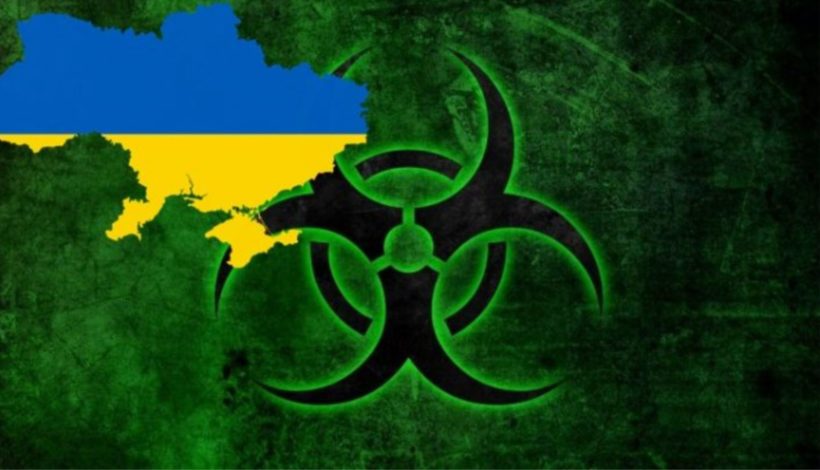Taken from Telegram channel of the Ministry of Defence of the Russian Federation – translation by Saker Latin America Community.
The following is the report of the “Briefing on the results of the analysis of documents related to the military biological activities of the United States on the territory of Ukraine” of 14 April 2022.
Documents: https://disk.yandex.ru/d/GWeH18ux9aL17g
A special military operation by Russian troops has yielded additional information on US military and biological activities in Ukraine, confirming numerous violations of the Biological Weapons Convention.
Taking advantage of loopholes in international law and the lack of a clear verification mechanism, the US administration has steadily developed its biological-military capabilities in various regions of the world.
The Russian Federation has made continuous efforts to establish a verification mechanism for the BTWC (Convention on the Prohibition of the Development, Production and Stockpiling of Bacteriological [Biological] and Toxin Weapons), but this initiative has been consistently blocked by the US-led Collective West since 2001.
The UN Secretary-General’s Mechanism to Investigate Suspected Use of Biological and Toxin Weapons, as well as the 1925 Geneva Protocol for the Prohibition of the Use of Asphyxiating, Poisonous or Other Bacteriological Gases and Methods of Warfare and Military Conflict, does not cover verification of the biological activities of States Parties. Nor does the Organisation for the Prohibition of Chemical Weapons, based in The Hague, have such authority.

Earlier we provided a schematic map of US coordination of biological laboratories and research institutes in Ukraine.
One of its elements is the Science and Technology Centre of Ukraine (STCU), a non-public organisation that apparently has nothing to do with the Pentagon.
The Russian Ministry of Defence has managed to uncover its role in US military and biological activities in Ukraine.
According to its statutes, the Ukrainian Science and Technology Centre is an international intergovernmental organisation established to “… prevent the spread of knowledge and experience related to weapons of mass destruction…”.
Its legal status is defined by the Agreement of 25 October 1993 between the governments of Ukraine, Canada, the United States and Sweden and the Protocol of Amendment of 7 July 1997.
The Ukrainian Science and Technology Centre has its headquarters in Kiev and regional offices in Baku (capital and most populous city of Azerbaijan. Translator’s note), Chisinau (capital and most populous city of Moldova. Translator’s note) and Tbilisi (capital and most populous city of Georgia. Translator’s note), as well as in Kharkov and Leopolis (major cities of Ukraine. Translator’s note).
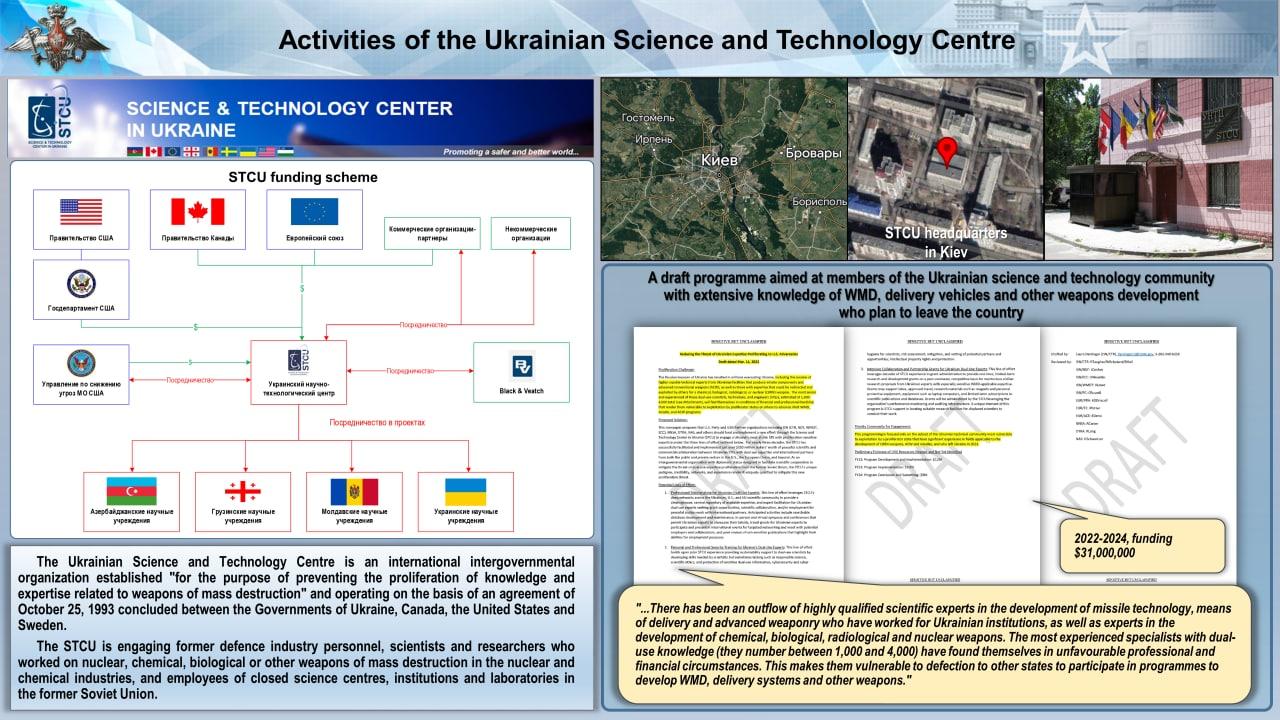
However, the Russian Ministry of Defence’s Centre of Expertise on Chemical and Biological Threats found that the main activity of the Ukrainian Science and Technology Centre (STCU) is to act as a hub for distributing grants for research of interest to the Pentagon, including biological weapons research.

In recent years alone, Washington has spent more than $350 million on STCU projects.
The US clients and sponsors of the Science and Technology Centre of Ukraine (STCU) are the State Department and the Department of Defense. Funding is also provided through the Environmental Protection Agency, the US Departments of Agriculture, Health and Energy.
In addition, note should be taken of the document produced by the curators of the Science and Technology Centre of Ukraine (STCU), dated 11 March 2022, which underlines the true nature of this organisation. It notes, quote: ‘…there has been an outflow of scientific experts in the development of means of delivery and advanced weaponry who have worked for Ukrainian institutions, as well as experts in the development of biological, radiological, chemical and nuclear weapons. The best-trained professionals with experience in working with dual-use materials and technologies (between 1,000 and 4,000 professionals) have found themselves in unfavourable professional and economic circumstances. This makes them vulnerable to defecting to other states to participate in WMD (Weapons of Mass Destruction. Translator’s note), delivery systems and other weapons development programmes…”.
By using such words, Washington actually acknowledges the work of Ukrainian experts in the field of WMD delivery system development and use, and considers it appropriate to continue their funding.
Here are the names of the officials who were involved in the military-biological programmes.
The post of Executive Director of the Science and Technology Centre of Ukraine (STCU) is held by Michael Curtis Bjelajac, a US citizen. Born on 27 August 1968 in California, he studied at Anderson University of Management in California. He holds a master’s degree in international finance and has worked in Ukraine since 1994.
The chairman, for the European Union, of the board of the Science and Technology Centre of Ukraine (STCU), is Eddie Arthur Maier; the director, for the US, is Phil Dolliff, who is the State Department’s Deputy Assistant Secretary for International Security and WMD Nonproliferation Programs.

Documents received by the Russian Ministry of Defence confirm the links of the Science and Technology Centre of Ukraine (STCU) with the US military department. The slide shows a formal recommendation from the US State Department endorsing the cooperation of the Science and Technology Centre of Ukraine (STCU) with the Pentagon’s prime contractor, Black & Veach. The correspondence expresses the willingness of Matthew Webber, the company’s vice president, to work with the Science and Technology Centre of Ukraine (STCU) on ongoing biological-military research in Ukraine.
Between 2014 and 2022, the Ukrainian Science and Technology Centre implemented five hundred R&D projects in post-Soviet countries (Ukraine, Georgia, Moldova and Azerbaijan).
The US supervisors were mainly interested in dual-use research, such as project 6166, “Development of Technologies for Modelling, Assessing and Predicting the Effects of Conflict and Threats of Spread of Weapons of Mass Destruction”, and project 9601, “Transfer to the European Union of Ukrainian Technologies for the Production of Complex Dual-Use Materials”.
Many of them are aimed at the study of potential biological weapons agents (plague, tularaemia) and economically important pathogens (pathogenic avian influenza, African swine fever).
Projects P-364, 444 and 781, aimed at studying the spread of dangerous pathogens via insect vectors, wild birds and bats, were funded by the Centre directly in the interest of the military department.

Please note the documents of Project 3007 “Monitoring of the epidemiological and environmental situation with regard to dangerous diseases of aquatic origin in Ukraine”.
During the work, Ukrainian specialists, supervised by US scientists, systematically collected water samples in several major Ukrainian rivers, including the Dnieper, Danube and Dniester, as well as in the North Crimean Canal, to determine the presence of particularly dangerous pathogens, including the pathogens of cholera, typhoid, hepatitis A and E, and to draw conclusions about their possible spread through water.
The project assessed the harmful properties of selected samples and deposited the strains in a collection and subsequently exported them to the US.
This is a map of Ukraine’s water resources. Their analysis shows that the results of this work can be used to create an unfavourable biological situation not only in the Russian Federation, but also in the Negro and the Sea of Azov, as well as in Eastern Europe: Belarus, Moldova and Poland.
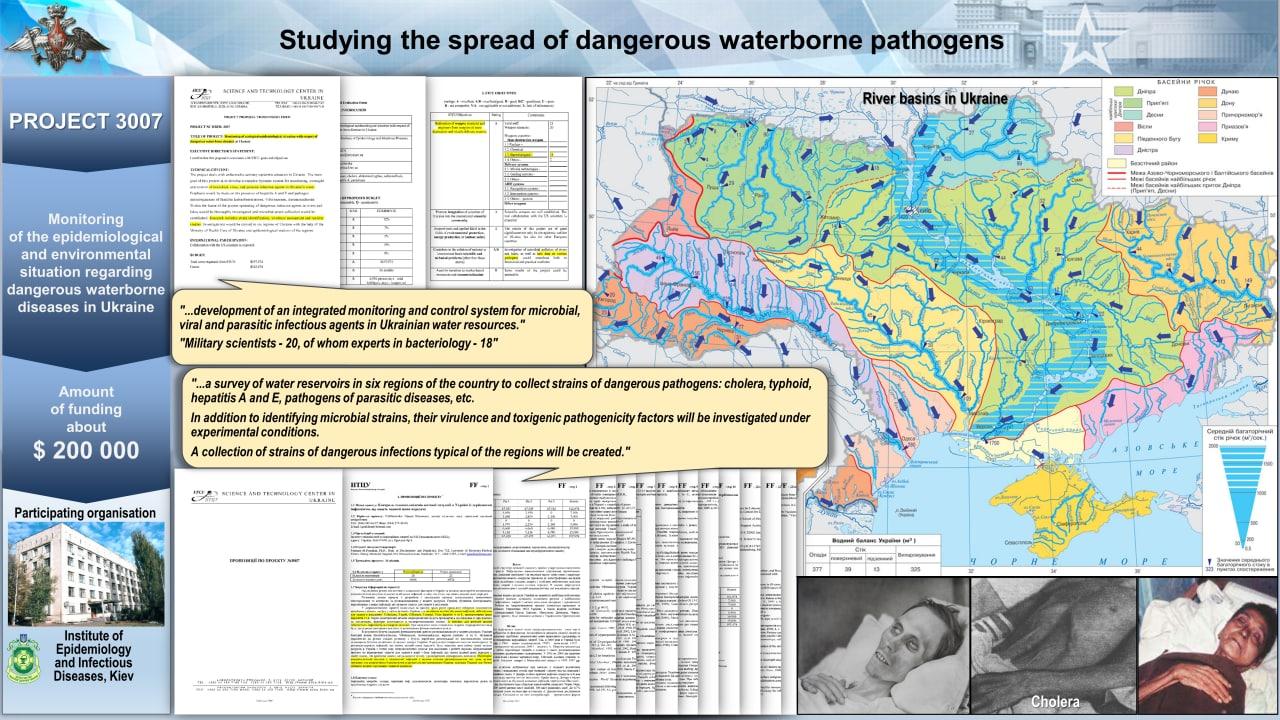
Our concern about Washington’s activities in Ukraine stems from the fact that, contrary to its international obligations, the United States has maintained norms in its national legislation that allow work in the field of biological weapons.
US ratification of the 1925 Geneva Protocol was accompanied by a number of reservations, one of which allows for the use of chemical and toxin weapons in retaliation.
Under the US Federal Unity and Cohesion Against Terrorism Act, biological weapons research is permitted with the approval of the US government. Participants in such research are not criminally liable for developing such weapons.
Thus, the US administration is implementing the principle that domestic law takes precedence over international law in this area. The most ethically controversial research is conducted outside of national jurisdictions.
Thus, during the special operation in Ukraine, it was established that US scientists at a laboratory in Merefa (Kharkov region) were testing potentially dangerous biological drugs on patients at the Regional Clinical Psychiatric Hospital No. 3 in Kharkov between 2019 and 2021.
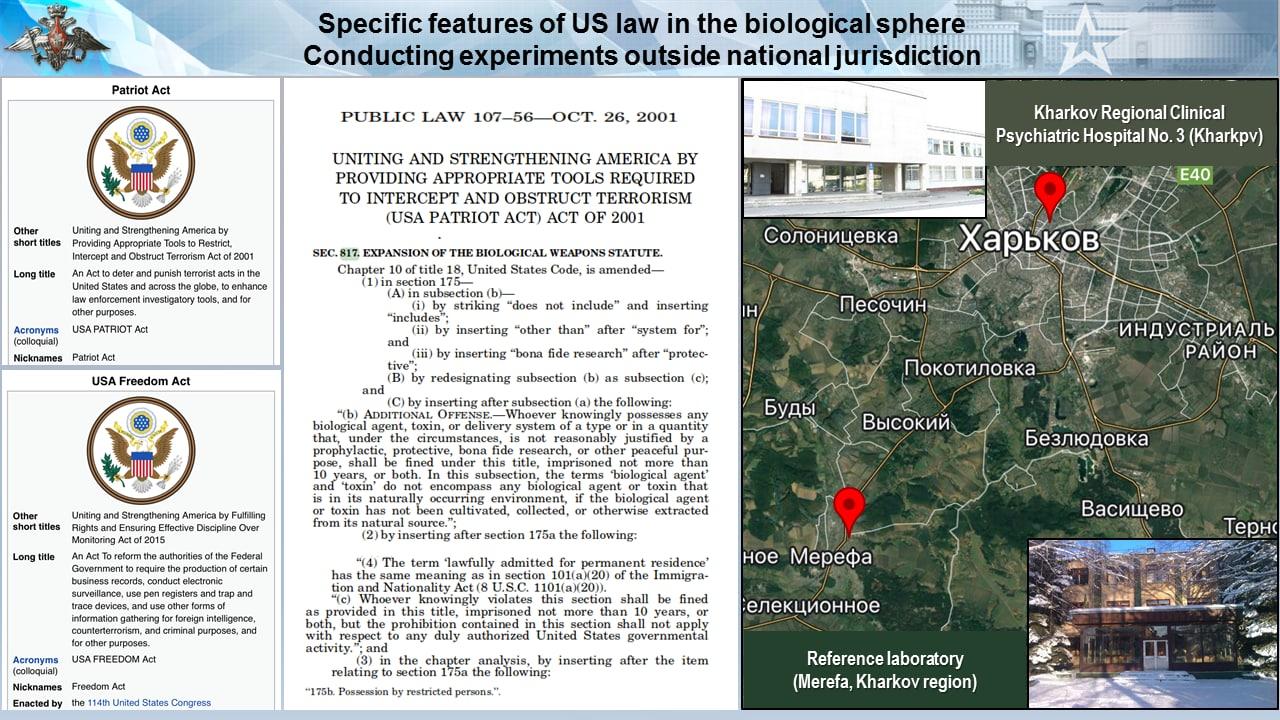
People with mental disorders were selected for the experiments on the basis of their age, nationality and immune status. Special forms were used to register the results of 24-hour patient monitoring. The information was not entered into the hospital database and the staff of the medical institution signed a confidentiality agreement.
In January 2022, the laboratory in Merefa was closed and all equipment and preparations were moved to the west in Ukraine.
There are several witnesses to these inhumane experiments, whose names we cannot reveal for the sake of their safety.
Finally, in a previous report, we described a technical device for the delivery and application of biological formulations that has been patented in the USA.
At the same time, it was noted that Ukraine had sent a request to the manufacturing company about the possibility of equipping Bayraktar drones with aerosol equipment.
It is a matter of concern that on 9 March, three UAVs equipped with 30-litre containers and equipment for spraying formulations were detected by Russian reconnaissance units in the Kherson region.
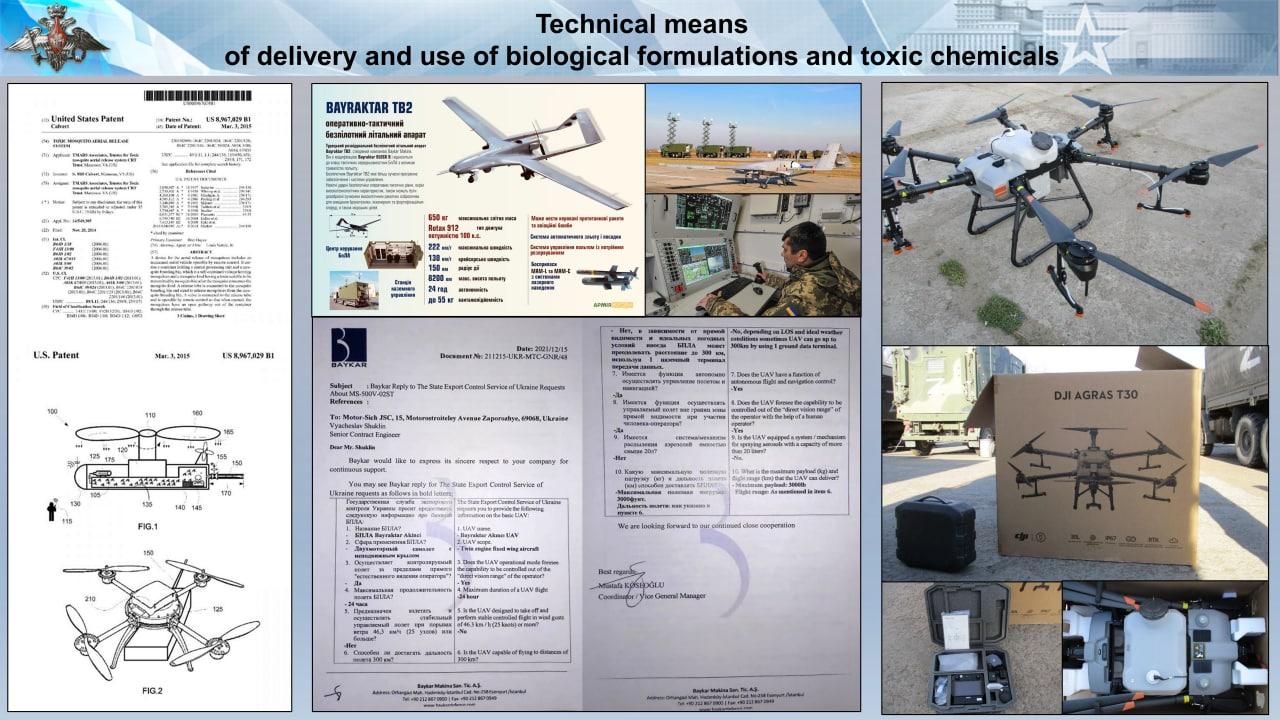
In January 2022, Ukraine reportedly purchased more than 50 of these devices through intermediary organisations, which can be used to apply biological formulations and toxic chemicals.
We continue to analyse the evidence of crimes committed by the US administration and the Kiev regime in Ukraine.
We recommend reading the article in US military biological activities on the territory of Ukraine – Saker Community Latin America (sakerlatam.es), where you can enlarge the photos.


